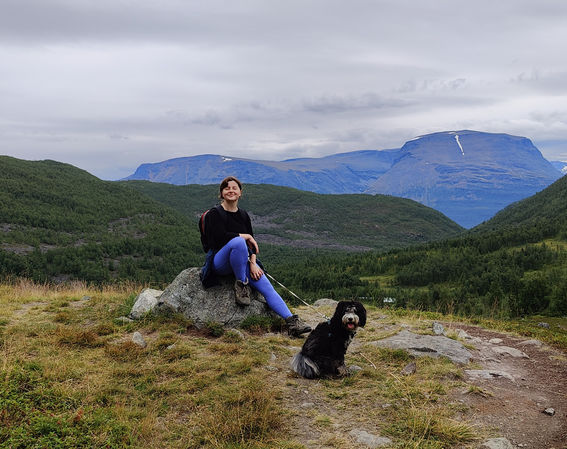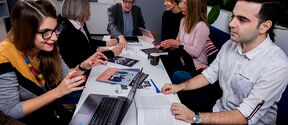Creative Sustainability Thesis Works
Creative Sustainability Thesis Works

I’m a regenerative designer-researcher from the UK (although this is a self-assigned job title that’s always changing!). I have a background in visual design and illustration, as well as place-based community engagement from when I studied and worked in London. I moved to Finland in 2020 to study Creative Sustainability and graduated from the programme around a year ago in December 2022!
I always wanted to work in sustainability, but maybe started with a bit of a one-dimensional idea of what sustainability meant, as in environmental sustainability. Working in a community engagement studio after my bachelors really kick-started a much more intersectional approach for me, seeing the correlations and connections between social, ecological, economic, cultural and political issues. This really made me want to learn more about how design and designers can play a role in this space - so I applied for CS!
The systemic and interconnected view that is so central to CS was great at connecting the dots and seeing how more ‘traditional’ design skills might be reapplied to tackle wicked problems. From the programme, I became especially interested in futures thinking and sustainability transitions, as well as how playfulness and imagination can be tools for these.
There’s never a straightforward answer to this, but I’ll do my best! At the moment I work both as an independent (freelance) designer-researcher, and as a core member of the Falay Transition Design collective.
In my independent work I still use my visual design background a lot, especially in communicating complex sustainability topics into more digestible and engaging formats - so using a lot of information, systems and service design approaches. I typically work with organisations who are active in eco-social sustainability work, such as charities or research companies. I’m especially proud of a project I finished this year with Adaptation Scotland, co-designing a community adaptation routemap.
At the Falay Transition Design collective, we’re a multidisciplinary group of designers, researchers and sustainability experts trying to take a more radical approach to sustainability consultancy. We have a lot of different interests in the group, but my key areas are using creative approaches to support sustainability transitions, and ‘hospicing’ of obsolete systems, as well as developing approaches for imagination and playful work to shift mindsets around sustainability issues.
I think my favourite parts are the bits where design and sustainability work feels empowering and motivational, rather than overwhelming and depressing (which it can be, a lot of the time). I’m so happy to be able to use imagination work throughout my practice, and have inspiring conversations about what a sustainable, regenerative future could actually look like, and how we can get there.
There’s a lot of pressure to get employed immediately after graduation. Throughout my CS master’s I was working as a freelancer, but only ever saw it as a short-term arrangement. After graduation I was encouraged by those around me to stick with it full-time, and I’m so glad I did. Don’t get me wrong, I understand this is a huuuge privilege that’s enabled by my passport, background and economic situation, but being an entrepreneur has meant that I’ve not needed to squeeze all my skills and interests into a relevant cover letter and dilute some of my more radical approaches for sustainability. It certainly has its challenges, but working as a freelancer has been a real freedom space to understand where and how to apply my skills.
I’m now a year into my kombucha-making journey! There have been a few explosions, and more than a few bad batches, but it’s lots of fun - and any Helsinki-based folk are more than welcome to come grab a starter kit from me!
I love textile crafts and have recently started a sewing-circle with friends to exchange skills and craft together. And then of course there’s my lovely dog Uma, who I love spending time with and taking on overland adventures with my partner.
CS wouldn’t be CS without its systemic teachings, and it’s really changed the way I approach problem spaces. Rather than trying to jump to a solution or address issues in isolation, zooming out and carefully investigating the full picture is such an important learning for designers, and especially for designing transitions.
Savannah Vize, Creative Sustainability alumnusRegenerative design is more-than-human!
I love the multiplicity of my work at the moment, and that’s something I would love to keep. At the moment I’m looking at avenues to explore more hopeful imagination work, alongside the themes of death and grieving when it comes to the climate crisis.
I’m using playful approaches in a lot of my work, but I would also love the opportunity to focus again on the value of play in sustainability - perhaps as an extension of my thesis work, or in another project.
Regenerative design is more-than-human! This was a switch in my brain that got flicked in the ‘Sustainability Transitions and Futures’ course, and has stayed that way ever since. Rather than taking a separatist view of ourselves from the environment, when we apply a planet-centric approach to design we embed a systemic, empathetic, conscious and much less extractive way of thinking, which is so so important.
"Braiding Sweetgrass" by Robin Wall Kimmerer
"From What Is to What If: Unleashing the Power of Imagination to Create the Future We Want" by Rob Hopkins
"Climate Justice" by Mary Robinson
Make the most of being able to tailor the degree to your interests - find a thesis topic that researches your niche interests, use course assignments to explore a bunch of different topics, and make the most of the flexible study right of Finnish universities by finding external courses to complement your transcript.
Find out more about studies in Creative Sustainability

Creative Sustainability Thesis Works

Creative Sustainability (CS) is a joint Master's degree programme at the School of Arts, Design and Architecture, School of Business and School of Chemical Engineering. Established in 2010, the CS programme brings students from a variety of fields together, to study and work in multidisciplinary teams and create novel sustainable solutions for human, urban, industrial and business environments. The pedagogical approach is based on integrating teaching and research, problem-based learning, design thinking, blended learning and strong connections to practical outcomes. The graduates of the programme have the endeavour to understand and address systemic phenomena and wicked problems.



